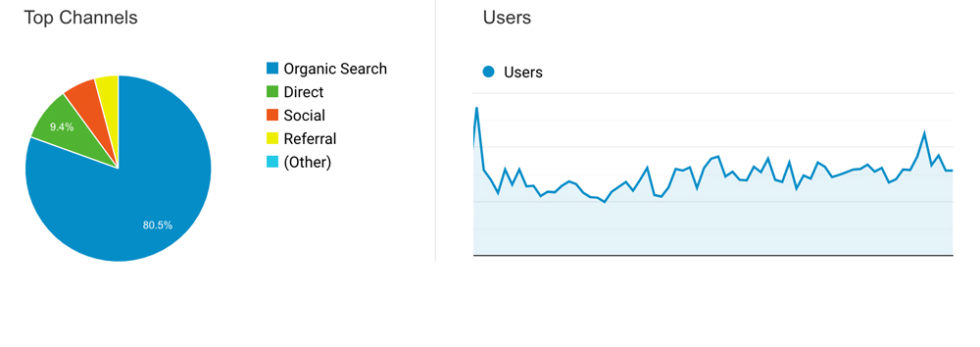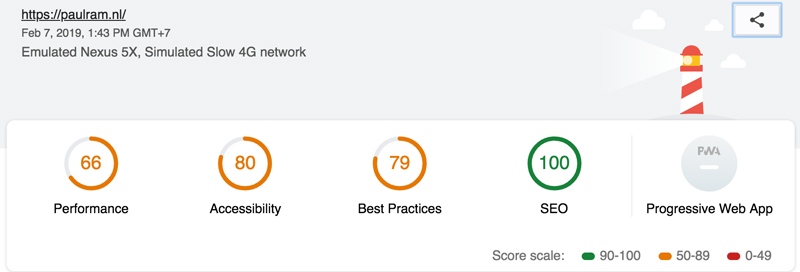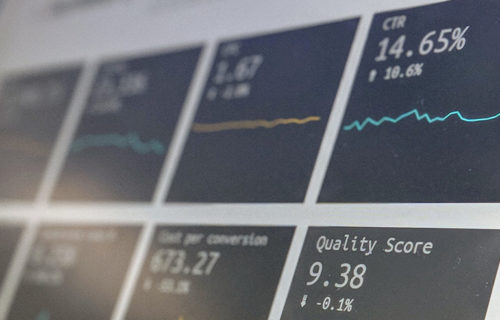
How to Increase Page speed and Google Page Score
Did you know that pagespeed and mobile access to your website have huge influence on the ranking in Google and the conversion rate on your website? read this article and I will explain more.
As you might know Google is always watching trends and optimises their ranking and search results for only one reason. Give people back the best search results and experience. One of the biggest changes over the last years is the usage of mobile connections and mobile phones while using the internet. Due to those changes Google made the decision that websites optimised for speed and mobile devices will rank higher in the search results.
NOTE: Google will always strive for the ultimate web for visitors and therefor will keep changing conditions for their raking system and the given points that belongs to that system. My Page Score on the moment of writing is 99* (February 2019)

How to test how fast your website is loading
Test what Google score your website has for Desktop And Mobile.
- Google Insights
- GT Metrix (extra tool)
- Pingdom Tools (extra tool)
Setting Goals before optimising Page score and Page speed
The speed and score can very, as your website/server can be busy, you installed new features(plugins) etc. Most important GOALS is my SEO score(1) and Page speed(2)
- SEO score: rank higher and attract more new visitors
- Page Speed: increase conversion and to turn more visitors into customers
How to Pagespeed close to /100 score and fast website helps you beyond search engine ranking!
When your have a great page score your website is more likely to rank higher in Google. Pagespeed combined with high quality technique and On Page SEO will make your website score to gain visitors. But another VERY important point of pagespeed is conversion optimisation while doing online lead generation.
Numbers from research have shown:
- 53% of the mobile visitors will leave a site if its not loaded before 3 seconds! (See more about this mobile stats)
- 30% of online shopping happens on the phone!
- 47% of people expect a site to load in less than 2 seconds (wired.com)
- 20% of users abandon their cart if the transaction process is too slow (radware.com)
- Amazon found every 100ms of latency cost them 1% in sales
- The BBC found they lost an additional 10% of users for every additional second their site took to load
Example: If your site makes 100K a day, 1 sec improvement will bring in 7K per day (see also infographic at the bottom)
I want that! But how to Pagespeed and how to get a close to/100 score
These results are meaningful for every online business, simple optimisation techniques can save thousands of dollars and increase the revenue a lot. Especially when you put your money into online advertising you want the best return on that investment. To show that everything is possible when you know the right people I show you this case. Since I started freelancing in 2008 I teamed up with Bas ten Broeke from Webcreationz.nl this guy has an absolute passion for the technique behind the website and I asked him to have a look to my site.
Note: all steps below are not rocket science, but can break your website when you’re not knowing what you’re doing.
The test before we are doing optimisations
- Shared hosting PHP 5.6
- 25/100 voor mobiel
- 60/100 voor desktop
- Load time 2.9
The website doesn’t have any heavy images or javascript codes and the WordPress theme is light weighted without much than just the basics. The Google page score and loading time are definitely a reasons to start optimising before promoting the website heavily.
Step 1: to Increase Pagespeed and Page Score:
Upgrade the PHP from 5.6 to 7.2
We started to check for bugs due to the old version of PHP. With WP_DEBUG on we saw a couple of errors that were directly the relatable to the old version of PHP. (You don’t see these bug on the front end of the website but will decrease the website in its loading time)
After we upgraded the PHP to PHP 7.2
| Shared hosting PHP 5.6 | Shared hosting PHP 7.2 | Difference |
| Mobile: 25/100 | 45/100 | 80% |
| Desktop: 60/100 | 78/100 | 30% |
When you’ve a WordPress website I highly recommend you to install PHP 7 or higher. This makes your website faster and that will reflect in a better page score.
Step 2 Updates WordPress and delete / clean Plugins
After installing the newer version of PHP we upgraded to the latest version of WordPress, we updated all plugins, removed unnecessary plugins and clean the plugins that were still running. (Cleaning the plugins/ database will help to speed up as the website doesn’t have to look as long for the information whats requested)
| Shared hosting PHP 5.6 | Shared hosting PHP 7.2 + WP updates | Difference |
| Mobile: 25/100 | 47/100 | 88% |
| Desktop: 60/100 | 80/100 | 33.33% |
As you can see a bug free, up to date website running on PHP 7.2 shows already a great improvements in the Google Page score.
TIP: if you don’t know if it is possible to switch your website to PHP 7.0+ or you’re a little but afraid contact us and can sort this out for you.
Step 3: From Shared hosting to a Virtual Private Server (VPS)
With the results we have so far we’re going to optimize further and will move the website from a shared hosting (an hosting that shares servers for multiple websites so you also share the speed, connections and capacity) to a Virtual private server. (Were your website is free to use ALL the capacity of that server)
Results after the move to the Virtual Private Server
| Shared hosting | VPS hosting | Difference |
| Mobile: 47/100 | 74/100 | 57.5% |
| Desktop: 80/100 | 89/100 | 11% |
A VPS doesn’t have to be much more expensive than a shared hosting. A VPS you can host already from 10 euro (12USD) per month.
Google Page Speed Score vs Page Speed Time
With the results presented we still have a Page Speed time of 2.0+ sec and 32 files to be requested to the server. Every file that will be requested the server need to respond to and deliver back a respond. The less and smaller the filer the better it is to increase your actual Page Speed.
WordPress plugins and PageSpeed
My website only uses 7 plugins, which I really need for functionality reasons. The less plugins you use the better it is, every plugins will bring in some more code and will decrease your page speed. The more plugins you use the harder it will be to increase your page speed but also to optimise you Google Page Speed Score.
Google gives you hint AND solutions ❤️
With the Insights page speed tool from Google you can check what you need to improve on. For example the images you need to optimize you can download and upload them to the right place on your server to overwrite the old images with the by Google optimised images. When you run the test you can see which images you need to optimise and can smush them at https://squoosh.app/ for example.
Step 4: Varnish Caching
A WordPress website is normally loaded from different part. The request of (for example the homepage) comes in at the server and the server will create the webpage. Simple said: Collect the data from the database, collect the images from the server, put them together in a design and sends back the web page. Some of the webpages are the same over and over again, they are called static pages. With caching you save those pages as one file, so when the request comes in the server only has to respond one file instead of collecting all the data again. In this step we configured the Varnish Caching and were able to generate the next results.
| Without Varnish caching | With Varnish caching | Difference |
| Mobile: 74/100 | 76/100 | 3% |
| Desktop: 89/100 | 90/100 | 1% |
Step 5 – Minify, combine and compress
We created the right base now to make the files as small as possible this is were you get the final results up towards the page speed score 100/100 on mobile and desktop. We’d like to work with the WP-Rocket Plugin. To make the final tweaks this plugin will give you a lot of options:
- Page Caching
- Cache Preloading
- Sitemap Preloading
- GZIP Compression
- Browser Caching
- Database Optimization
- Google Fonts Optimization
- Remove Query Strings from Static Resources
- Lazyload
- Minification / Concatenation
- Defer JS Loading
- CDN
- DNS Prefetching
- Mobile Detection
With all these options you can for example, remove all the from you files, remove all the comments in the codes combine files to one file. As said before, the less files and the smaller the files the faster the website will load. Its important to test different settings and combination of settings. WordPress websites are almost never the same as they use different themes, plugins and combination of plugins. So this required some testing to find an ultimate result and perfect page speed. My advise is when you start testing with the WP-Rocket plugin always do this on a testserver or staging server.
Choose a theme wisely or build a custom theme
When you want to build a website on a existing theme make sure you pick a theme that can meet your expectations around page speed and optimisation. When you hire a developer to create a theme for you make sure you talk about the pagespeed results you expect them to be. Technique can never be the obstacle to make concessions to design or user experience. If you want we will work out a way that both will go together.
EXTRA TIP:
Important when you have optimised your website, go though all the different pages to see if they work properly and no functionality has broken. Also test the different pages in the Google Page Speed Optimiser tool. If the homepage is optimised the other pages might still need a review. Make a list of pages and just test them with your team.
As this theme is a light weight WordPress theme is it not very hard to generate a 100/100 page speed score. Lets have a look were we started, the final results and the difference it had for mobile and desktop.
| Base | Met WP Rocket + right settings | Difference |
| Mobile: 25/100 | 100/100 | 300% |
| Desktop: 60/100 | 100/100 | 66.7% |
* This test was done before phase two of developing extra functionality to the website. Although when you look to the results below I’m still very happy with what came out of the optimisation process!
MOST HAPPY WITH
Page load time less than ONE second & SEO score is 100 (tested with Google lighthouse).


None of my visitors is going to look what my current page speed score is, thats only for Google.
They just want a ULTRA FAST website and that is the goals I achieved with going through this steps with Bas ten Broeke of Webcreationz.
Check the current pagespeed score paulram.nl
Check current pagespeed score Webcreationz.nl
DO you want a ULTRA FAST website like we PROOF?
Fill in the simple form and I will get in touch ASAP.
BONUS tips
Imagify – Image smushing
This tool gives you the opportunity to generate images to the required sizes in one go. It will save you some time and will increase the page speed of your website.
CDN – Content Delivery Network
A CDN (Content Delivery Network) is a network of servers all over the world that will make a copy of your website. When someone on the world will request your website. The CDN will serve the files for your website from the closest server to the computer that made the request. For example your business is in Australia. But your CDN has servers all over the world. Someone that requests your website in Germany can get the files served from Frankfurt and the files don’t have to travel 10.000 kilometers towards Germany.
Plugin – Plugin organizer
With this plugin you can manage your plugins per page. For example if you have a gallery on one page and the plugin is loading a lot of code into the header of every page someone visits its killing for your page speed. With this plugin you can manage to only have that plugin active on the page where the gallery is active. This way the rest of the website pages don’t load any unnecessary code and scripts.
Want to improve your page speed but don’t know where to start?
If you’ve questions let me know and I can help you to improve your page speed.
Want to learn how to simple do you on page search engine optimisation check this post.
How page speed affects your website infographic





Add A Comment